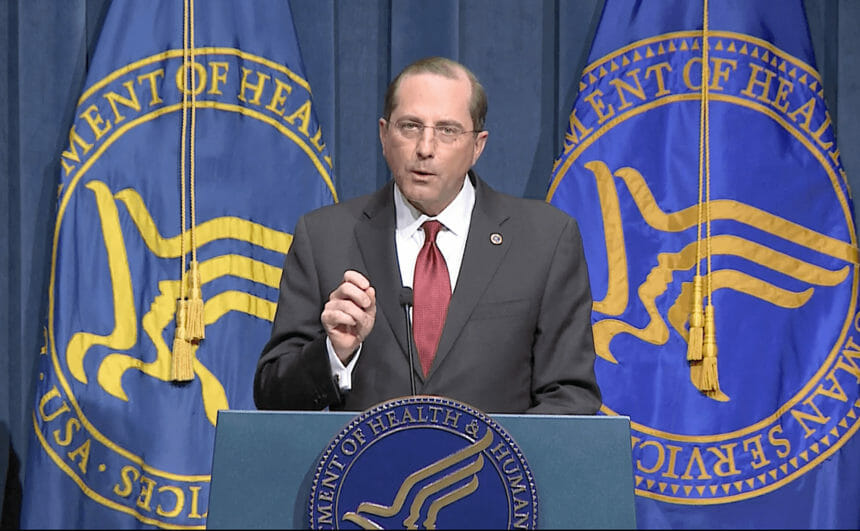
In a move that should open COVID-19 vaccination to independent living and affordable senior housing residents across the country, officials with the federal vaccine development, manufacturing and distribution program on Tuesday announced an expansion of the program to enable anyone aged 65 or more years to be vaccinated.
Those younger than 65 who have comorbidities also will be able to be vaccinated, as long as they have the medical documentation required by the state in which they live, Health and Human Services Secretary Alex Azar said during an Operation Warp Speed press conference.
The expansion of the vaccination rollout, four weeks after it began, had been part of the “vaccine playbook” sent to the states in September, he said. Implementation details are up to the states, and some states already may have started vaccinating these populations.
“We have achieved several milestones, several triggers, that brought us to this point,” Azar said. “Nearly 38 million total doses of vaccine to date, including about 25 million first doses, have been made available for states to order against, with more becoming available this week. The doses allocated exceeds the priority populations in group 1a, including frontline health workers and seniors living in long-term care facilities, which means that supply now exceeds demand from those groups.”
Other milestones reached, he said, were consistent vaccine production and increased confidence in the distribution system.
Army Gen. Gustave Perna, chief operating officer of Operation Warp Speed, said that 70,000 assisted living communities and nursing homes are enrolled in the voluntary Pharmacy Partnership Program for Long-Term Care, with almost 1 million doses being given through the program at more than 11,000 facilities to date and 12,000 more clinics scheduled for this week. By the end of next week, 95% of long-term care facilities will have had their first vaccine clinics, Azar said. Overall, more than 9 million doses have been administered across the United States.
But affordable senior housing residents and independent living residents were not considered among the priority groups in phase 1a of the vaccine rollout, even if they lived in continuing care retirement communities where other residents were considered a priority. That led groups such as the American Seniors Housing Association to write to state governors to advocate on their behalf.
‘Heavy-handed micromanagement’
The vaccine has not been available to more people sooner, the HHS secretary said, because of “heavy-handed micromanagement” of the vaccination process in some states that went against recommendations from the Centers for Disease Control and Prevention.
“There was never a reason that states needed to complete vaccinating all healthcare providers before opening vaccinations to older Americans and other vulnerable populations. States should not be waiting to complete 1a priorities before proceeding to broader categories eligibility,” he said. “Think of it like boarding an airplane. You might have a sequential order in which you board people, but you don’t wait until literally every person from a group is boarded before moving onto the next.”
Expanding from phase 1a, however, is not necessarily “declaring victory for that category,” he said. “States should continue working to support vaccinations of those populations.”
To further speed vaccinations, federal officials also will tell states to allow vaccines to be given at more sites, including pharmacies, community health centers and mass vaccination sites, Azar said. And the federal government is making available the full reserve of doses rather than holding back some vaccines for second shots, while ensuring that second doses will be available for everyone who gets a first dose, he added. Each of the currently approved vaccines requires two doses for optimal effectiveness.
Additionally, beginning in two weeks, first doses of vaccines will be allocated to states based on their self-reported pace of administration and by the size of their 65-and-over population, Azar said.
“This new system gives states a strong incentive to ensure that all vaccinations are being properly reported, which they’re currently not,” he said. “And it gives states a strong incentive to ensure doses are going to work protecting people rather than sitting on shelves or in freezers.”
Two COVID vaccines are available now, but four more are being investigated with government funding. Additional vaccines may receive emergency use authorization in February, March and April, predicted Moncef Slaoui, Ph.D. The Operation Warp Speed chief science adviser resigned sometime on Tuesday at the request of the incoming Biden administration but will stay for 30 days to help with the transition, according to media reports.
Other precautionary measures
CDC Director Robert Redfield stressed the continued importance of hand-washing, mask-wearing and social distancing as the country experiences a post-holiday disease surge.
“Most of the transmission that is occurring in our nation right now is not occurring in the public square. It’s occurring one household to one household to one household,” he said.
Redfield predicted “a difficult January and probably February, but with the vaccine and the new therapeutics we have, there’s really strong light at that end of that tunnel as we enter March.”
Azar said that, in addition to taking other precautions, anyone over the age of 65 or with a comorbidity should ask his or her healthcare provider to be given one of the Food and Drug Administration-authorized monoclonal antibody therapies that are available.
“We have products sitting on the shelves that can help keep people out of the hospital,” he said. Not using them, Azar said, “is just as unacceptable as vaccines sitting on shelves unused.”



